Python 官方文档:入门教程 => 点击学习
[root@kaibin ~]# ipython In [1]: import platfORM In [2]: print platform.uname() ('linux', 'kaibin.test1', '2.6.32-431.el
[root@kaibin ~]# ipython
In [1]: import platfORM
In [2]: print platform.uname()
('linux', 'kaibin.test1', '2.6.32-431.el6.x86_64', '#1 SMP Fri Nov 22 03:15:09 UTC 2013', 'x86_64', 'x86_64')
In [3]: dir(platform) #查看platform支持的功能:dir(platform)
In [4]: exit()简单方法:
1.编译安装新版本至某特定路径:
2.pyenv
源码包安装python:
[root@kaibin ~]# ll Python-2.7.6.tgz
-rw-r--r--. 1 root root 14725931 1月 25 2015 Python-2.7.6.tgz
[root@kaibin ~]# tar xvf Python-2.7.6.tgz
依赖readlinde-devel开发程序
[root@kaibin ~]# yum -y install readline-devel
[root@kaibin ~]# cd Python-2.7.6
[root@kaibin Python-2.7.6]# ls
config.guess configure.ac Grammar Lib Makefile.pre.in Objects PCbuild README Tools
config.sub Demo Include LICENSE Misc Parser pyconfig.h.in RISCOS
configure Doc install-sh Mac Modules PC Python setup.py
[root@kaibin Python-2.7.6]# ./configure --prefix=/usr/local/python-27
checking build system type... x86_64-unknown-linux-gnu
checking host system type... x86_64-unknown-linux-gnu
checking for --enable-universalsdk... no
checking for --with-universal-archs... 32-bit
checking MACHDEP... linux2
checking EXTRAPLATDIR...
checking for --without-GCc... no
checking for gcc... no
checking for cc... no
checking for cl.exe... no
configure: error: in `/root/Python-2.7.6':
configure: error: no acceptable C compiler found in $PATH
See `config.log' for more details
需要安装 gcc
[root@kaibin Python-2.7.6]# yum -y install gcc
[root@kaibin Python-2.7.6]# ./configure --prefix=/usr/local/python-27
[root@kaibin Python-2.7.6]# make && make install
Tab补全功能:(为ipython功能模块
[root@kaibin ~]# wget Http://arcHive.ipython.org/release/1.2.1/ipython-1.2.1.tar.gz
[root@kaibin ~]# tar xf ipython-1.2.1.tar.gz
[root@kaibin ~]# cd ipython-1.2.1
[root@kaibin ipython-1.2.1]# /usr/local/python-27/bin/python2.7 setup.py build
[root@kaibin ipython-1.2.1]# /usr/local/python-27/bin/python2.7 setup.py install
[root@kaibin ipython-1.2.1]# ln -sv /usr/local/python-27/bin/python2.7 /usr/bin/python2.7
"/usr/bin/python2.7" -> "/usr/local/python-27/bin/python2.7"
[root@kaibin ipython-1.2.1]# ln -sv /usr/local/python-27/bin/ipython /usr/bin/ipython
"/usr/bin/ipython" -> "/usr/local/python-27/bin/ipython"通过某种方式(例如对元素进行编号)组织在一起的数据元素的集合,这些元素可以是数字或者字符,甚至可以是其他的数据结构
Python最基本的数据结构是序列
序列中的每个元素被分配一个序号--即元素的位置,也成为索引:索引从0开始编号
Python包含6种内建的数据序列:列表,元组,数字串
Unicode字符串,buffer对象和xrange对象
Python的关键要素
1.基本数据类型
2.对象引用
3.组合数据类型
4.逻辑操作符
5.控制流语句
6.算数操作符
7.输入/输出
8.函数的创建与调用
1. 基本数据类型
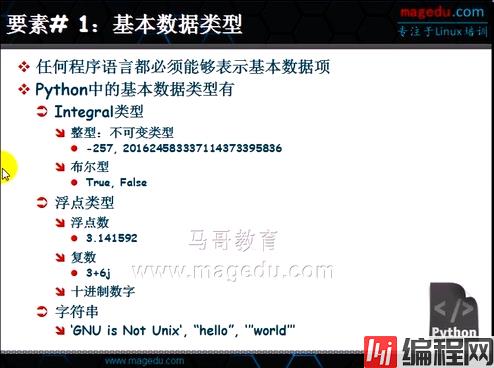
变量赋值:
数字:
In [8]: num=1
In [9]: id(num)
Out[9]: 32365672
In [10]: num=2
In [11]: id(num)
Out[11]: 32365648
字母:
In [12]: name="Jerry"
In [15]: print name[0]
J
In [13]: print name[1]
e
In [14]: print name[2]
r
In [16]: id(name)
Out[16]: 43542256
查看变量类型:
In [17]: type(num)
Out[17]: int
In [18]: type(name)
Out[18]: str
#查看platform支持的功能:dir(platform)
In [3]: dir(platform)2.对象引用
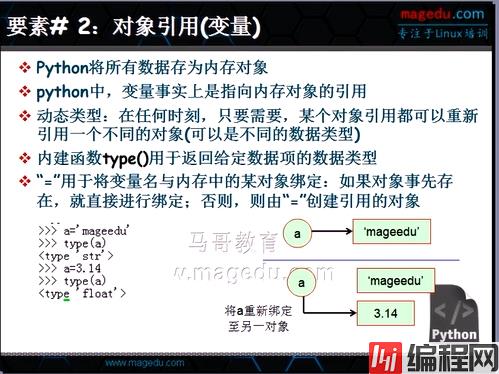
In [1]: name="Jack" #字符串是不可变量
In [2]: id(name)
Out[2]: 41585664
In [3]: iname="Jack"
In [4]: id(iname)
Out[4]: 41585664变量规则
*只能包含字母,数字,和下划线,且不能以数字开头
*区分字母大小写
*禁止使用保留字(系统中的关键字)
Python2和Python3的保留字有所不同
命名惯例
*以单一下划线开头的变量名(_x)不会被from module import*语句导入
*前后有双下划线的变量名(__x__)是系统定义的变量名,对Python解释器有特殊的意义
*以两个下划线开头但结尾没有下划线的变量名(__x)是类的本地变量
*交互模式下,变量名"_"用于保存最后表达式的结果
In [1]: 1+1
Out[1]: 2
In [2]: print _注意:变量名没有类型,对象才有
In [7]: name="Jack"
In [8]: type(name)
Out[8]: str
In [9]: name=3.14
In [10]: type(name)
Out[10]: float3.组合数据类型
数据结构
通过某种方式(例如对元素进行编号)组织在一起的数据元素的集合
Python常用的数据类型
序列类型
*列表:使用[]创建
In [11]: a1=["This","is","a","Pig"]
In [12]: a1[0] #引用对象
Out[12]: 'This'
In [13]: a1[0][0]
Out[13]: 'T'*元组:使用()创建,如('one','two')
In [14]: t1=("This","is")
In [15]: t1[0]
Out[15]: 'This'
In [16]: t1[1]
Out[16]: 'is'
In [17]: t1[0][0]
Out[17]: 'T'列表和元组的区别
In [11]: a1=["This","is","a","Pig"]
In [18]: print a1
['This', 'is', 'a', 'Pig']
In [19]: a1[3]="sheep"
In [20]: print a1
['This', 'is', 'a', 'sheep']
In [21]: id(a1)
Out[21]: 45304216
In [22]: a1[3]="Jack"
In [23]: id(a1)
Out[23]: 45304216 #前后内存空间位置一致
In [14]: t1=("This","is")
In [24]: print t1
('This', 'is')
In [28]: t1[1]="what" #尝试修改,但是报错,无法修改
---------------------------------------------------------------------------
TypeError Traceback (most recent call last)
<ipython-input-28-367d778d7cb3> in <module>()
----> 1 t1[1]="what"
TypeError: 'tuple' object does not support item assignment*字符串也属于序列类型
In [29]: name="Jerry"
In [30]: name[0]
Out[30]: 'J'
In [31]: name[0:1]
Out[31]: 'J'
In [32]: name[0:2]
Out[32]: 'Je'
In [33]: name[:2]
Out[33]: 'Je'
In [34]: name[2:]
Out[34]: 'rry'
In [35]: name[0:4]
Out[35]: 'Jerr'
In [36]: name[0:4:2]
Out[36]: 'Jr'集合类型
集合
映射
字典
字典是可变对象,元组是不可变序列
Python中,组合数据类型也是对象,因此其可以嵌套
实质上,列表和元组并不是真正存储数据,而是存放对象引用
Python对象可以具有其可以被调用的特定"(方法函数)"
元组,列表以及字符串等数据类型是"有大小的",其长度可使用内置函数len()测量
In [37]: print name
Jerry
In [38]: len(name) #获取元素个数
Out[38]: 5
In [39]: print a1
['This', 'is', 'a', 'Jack']
In [40]: len(a1)
Out[40]: 44.逻辑操作符
*逻辑运算时任何程序设计语言的基本功能
*Python提供了4组逻辑运算
*身份操作符
is:判定左端对象引用是否相同于右端对象引用;也可以与None进行;
In [7]: name="Hello"
In [8]: name1="Hi"
In [9]: name is name1
Out[9]: False
In [10]: name="Hello"
In [11]: name1="Hello"
In [12]: name is name1
Out[12]: True
In [13]: type(name) is type(name1)
Out[13]: True*比较操作符
<,>,<=,>=,!=,==
*成员操作符
in或not in:测试成员关系
*逻辑运算符
an,or,not
5.控制流语句
*控制流语句是过程式编程语句的基本控制机制
*python的常见控制流语句
if
while
for...in
try
6.算数操作符
*Python提供了完整的算数操作符集
*很多的Python数据类型也可以使用增强型的赋值操作符,如+=,-=
*同样的功能使用增强型的赋值操作符的性能较好
*Python的int类型是不可变的,因此,增强型赋值的实际过程是创建了一个新的对象来存储结果后将变量名执行了重新绑定
7.输入输出
*现实中,具有实际功能的程序必须能够读取输入(如从键盘或文件中),以及产生输出,并写到终端文件中;
*Python的输入/输出
输出
python3:print()函数
Python2: print语句
输入
input()
raw_input()
In [14]: raw_input("please input a num:")
please input a num:4
Out[14]: '4'
In [16]: a=raw_input("please input a num:")
please input a num:b
In [18]: print a
b*Python解释器提供了3种标准文件对象,分别是标准输入,标准输出和标准错误,他们在sys模块中分别以sys.stdin,sys.stdout,和sys.stderr形式提供
*Python的print语句实现打印一一一个对程序友好的标准输入流接口
*从技术角度来讲,print是把一个多或者多个对象转换为其文本表达形式,然后发送给标准输入或者另一个类似文件的流
在Python中,打印与文件和流的概念联系紧密
文件写入方法是把字符串写入到任意文件
print默认把对象打印到stdout流,并添加了一定的格式化
实质上,print语句只是Python的人性化特征的具体实现,他提供了sys.stdout.write()的简单接 口,再加上一些默认的格式设置
print结构一个逗号分隔的对象列表,并为行尾自动添加一个换行符,如果不需要,则在最后个元素后添加逗号
In [19]: a="Jack"
In [20]: b="Tom"
In [21]: print a,b
Jack Tomprint的格式化输出:
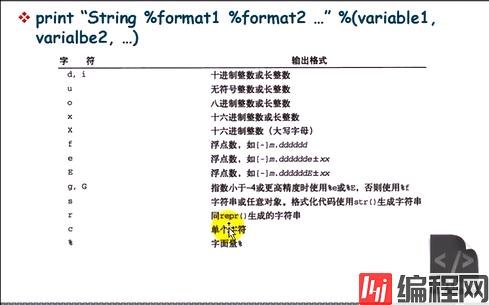
In [23]: num=7.9
In [24]: print "The num is %f" % num
The num is 7.900000
In [25]: print "The num is %d" % num
The num is 7
In [26]: num1=9.13
In [27]: print "The nums are %d and %f" %(num,num1)
The nums are 7 and 9.130000
In [28]: print "The nums are %d and %f" %(num,3.1)
The nums are 7 and 3.100000
In [29]: print "The nums are %e and %f" %(num,3.1)
The nums are 7.900000e+00 and 3.100000数据类型的转换:
In [23]: num=7.9
In [30]: name="hello"
In [31]: print "The name is %s." %name
The name is hello.
In [32]: print "The name is %s." %num
The name is 7.9.
In [33]: test1=str(num)
In [34]: type(test1)
Out[34]: str
In [35]: type(num)
Out[35]: float查看常用的内置函数(由内建函数引用)
In [39]: dir(__builtins__)
Out[38]:
['ArithmeticError',
'AssertionError',
'AttributeError',
'BaseException',
'BufferError',
'BytesWarning',
'DeprecationWarning',
.....查看函数用法
In [39]: help(str)
In [40]: name="jack"
In [41]: name.upper()
Out[41]: 'JACK'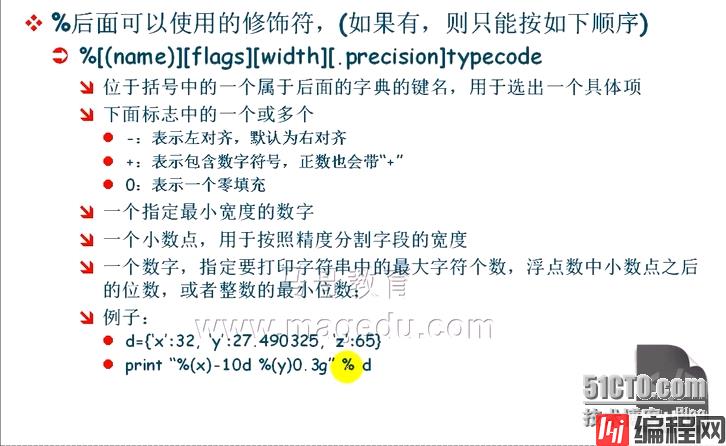
In [42]: print "The nums are %e and %f" %(num,3.1)
The nums are 7.900000e+00 and 3.100000
In [43]: print "The nums are %+e and %f" %(num,3.1)
The nums are +7.900000e+00 and 3.100000
In [44]: print "The nums are %+e and %f" %(num,-3.1)
The nums are +7.900000e+00 and -3.100000
In [45]: print "The nums are %f and %f" %(num,-3.1)
The nums are 7.900000 and -3.100000
In [46]: print "The nums are %+f and %+f" %(num,-3.1)
The nums are +7.900000 and -3.100000
In [48]: print "The nums are %+20f and %+f" %(num,-3.1)
The nums are +7.900000 and -3.100000
In [50]: print "The nums are %-20f and %+f" %(num,-3.1)
The nums are 7.900000 and -3.100000
In [5]: print "The nums are %+20.10f and %+f" %(num,-3.1)
The nums are +7.9000000000 and -3.100000
In [7]: print "The nums are %+20.15f and %+f" %(num,-3.1)
The nums are +7.900000000000000 and -3.100000字典:键值的集合(kv集合)
In [9]: d1={'a':31, 'b':68}
In [10]: d1['a']
Out[10]: 31
In [11]: d1={1:31, 2:68}
In [12]: d1[1],d1[2]
Out[12]: (31, 68)
In [8]: d1={'a':31,'b':66}
In [9]: print "The float is %(a)f." %d1
The float is 31.000000.
In [10]: d2={0:31,1:66}
In [11]: d2[0]
Out[11]: 31
In [12]: print "The float is %(0)f." %d2 #尝试用数字元素,但是失败
---------------------------------------------------------------------------
KeyError Traceback (most recent call last)
<ipython-input-12-f157136aebc0> in <module>()
----> 1 print "The float is %(0)f." %d2
KeyError: '0'8.函数的创建与调用

In [14]: def printName(name): #自定义函数printName
....: print name
....:
In [15]: printName("Jack") #调用printName函数,传参"Jack"
Jack
In [16]: test="Hello"
In [17]: printName(test)
Hello
In [19]: callable(printName) #查看函数是否能够调用
Out[19]: True
In [21]: dir(__builtin__) #查看可用内置函数
Out[21]:
['ArithmeticError',
'AssertionError',
'AttributeError',
'BaseException',
'BufferError',
'BytesWarning',
'DeprecationWarning',
'EOFError',
'Ellipsis',
......
In [23]: help(range) #查看range的用法
In [24]: range(10)
Out[24]: [0, 1, 2, 3, 4, 5, 6, 7, 8, 9]
In [27]: range(1,11)
Out[27]: [1, 2, 3, 4, 5, 6, 7, 8, 9, 10]
In [28]: range(2,11,2)
Out[28]: [2, 4, 6, 8, 10]import相当于bashell中的source
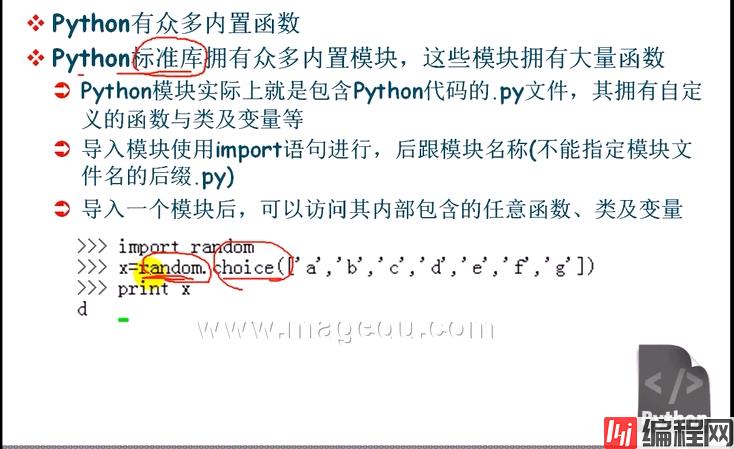
In [29]: import random #加载random模块
In [30]: random.random() #随机生成一个随机数
Out[30]: 0.10932424859218137
In [32]: students=['a','b','c','d'] #定义一个列表
In [33]: random.choice(students) #从中随机选取一个参数
Out[33]: 'b'
In [34]: random.choice(students)
Out[34]: 'c'--结束END--
本文标题: Python学习笔记(二)Python基
本文链接: https://www.lsjlt.com/news/182960.html(转载时请注明来源链接)
有问题或投稿请发送至: 邮箱/279061341@qq.com QQ/279061341
下载Word文档到电脑,方便收藏和打印~
2024-03-01
2024-03-01
2024-03-01
2024-02-29
2024-02-29
2024-02-29
2024-02-29
2024-02-29
2024-02-29
2024-02-29
回答
回答
回答
回答
回答
回答
回答
回答
回答
回答
0